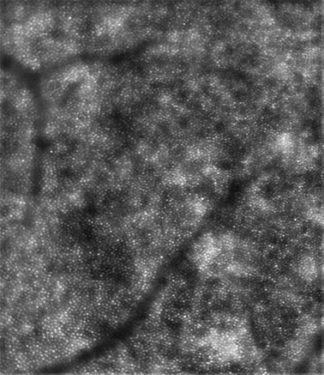Methods and devices of early diagnosis of retinal diseases
Vision Engineering Italy is committed to the development of computerized methods for early detection of retinal diseases.
Adaptive optics is a technique developed by astronomers to improve the image quality of celestial objects acquired by
ground telescopes.

IMMAGINE Image of retinal photoreceptors. Adaptive optics allows to resolve individual retinal cells in vivo. Each cell has a diameter of a few micrometers. Thanks to adaptive optics, it will be possible to diagnose retinal pathologies early in the course of the disease, thus saving sight to millions of people.
Adaptive optics is a technology for correcting ocular optical aberrations. The current diagnostic tools of retinal and optic nerve diseases, such as OCT and ophthalmoscopy, are strongly limited by optical aberrations. Adaptive optics retinal imaging has a resolution 5 times higher than the best ophthalmic instruments currently used in clinic. It allows to observe the individual retinal microstructures, such as cells (photoreceptors), capillaries and nerve fibers. The new technology has been used for more than ten years and has provided new and significant knowledge of the anatomy and physiology of the retina and optic nerve. Adaptive optics retinal imaging will provide the eye doctors with a powerful tool for the early diagnosis of the most common eye diseases, such as macular dystrophies and glaucoma.
The co-founders of Vision Engineering Italy have been committed to the development of adaptive optics technology since 2002. The experience gained in these years is the strength of our staff. We have been collaborating with the most important research centers in the world aiming at accelerating the translation of this technology to clinic. Since retinal and optic nerve diseases are currently diagnosed only after the onset of significant and irreversible retinal damages, the early diagnosis may represent the first step for treating tissue damage early in the course of the disease and protect sight. The development of methods and tools that are able to resolve the pathological changes of the retina at a cellular level is vital to achieve this objective.
Publications
- Mariotti L, Devaney N, Lombardo G, Lombardo M. Analysis of cone mosaic reflectance properties in healthy eyes and in eyes with non-proliferative diabetic retinopathy over time. Invest Ophthalmol Vis Sci 2017;58(10):4057-4067.
- Giannini D, Lombardo G, Mariotti L, Devaney N, Serrao S, Lombardo M. Reliability and agreement between metrics of cone spacing in adaptive optics images of the human retinal photoreceptor mosaic. Invest Ophthalmol Vis Sci 2017;58(7):3127-3137.
- Mariotti L, Devaney N, Lombardo G, Lombardo M. Understanding the changes of cone reflectance in adaptive optics flood illumination retinal images over 3 years. Biomed Opt Expr 2016; 7: 2807-2822.
- Cooper RF, Lombardo M, Carroll J, Sloan KR, Lombardo G. Methods for investigating the local spatial anisotropy and the preferred orientation of cones in adaptive optics retinal images. Vis Neurosci 2016, 33: e005.
- Lombardo M, Parravano M, Serrao S, Ziccardi L, Giannini D, Lombardo G. Investigation of Adaptive Optics Imaging Biomarkers for Detecting Pathological Changes of the Cone Mosaic in Patients with Type 1 Diabetes Mellitus. PLoS One 2016; 11(3):e0151380.
- Lombardo M, Scarinci F, Giannini D, Pileri M, Ripandelli G, Stirpe M, Lombardo G, Serrao S. High-resolution multimodal imaging following idiopathic epiretinal membrane surgery. Retina 2016; 36(1): 171-180.
- Ziccardi L, Giannini D, Lombardo G, Serrao S, Dell’Omo R, Nicoletti A, Bertelli M, Lombardo M. Multimodal approach to monitoring and investigating cone structure and function in an inherited macular dystrophy. Am J Ophthalmol, 2015; 160(2):301-312.e6
- Scarinci F, Lombardo M. Microscopic inner retinal hyperreflective structures in eyes with epiretinal membrane using adaptive optics scanning laser ophthalmoscopy. Retina 2020, Aug 3; E-published.
- Ziccardi L, Di Renzo A, Picconi F, Parisi V, Lombardo M, Frontoni S, Parravano M. Early and localized retinal dysfunction in patients with type 1 diabetes mellitus studied by multifocal electroretinogram. Acta Diabetologica 2018 Nov;55(11):1191-1200.

